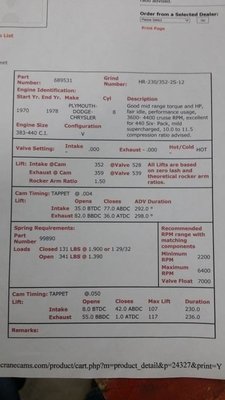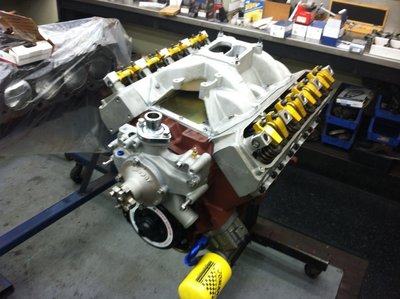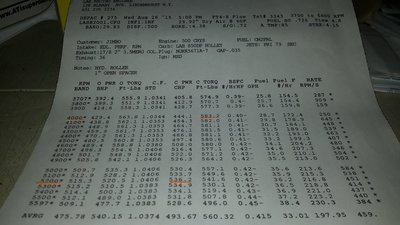cdr
Well-Known Member
Trying to compare what a chevy Hrdro vs Solid roller set up does to a mopar roller conversion is, NOTHING is applicable .
Don't know what you mean by hard on. If you use the proper valve train parts, that are made to handle the job, then the parts should last. Some guys have posted on here that they had a hyd cammed motor that would lose power above 5000 RPM. They put solid lifters on the cam, set the lash at .005" hot, and the motor picked up a fair amount of top end power. I won't mention any names, but I do believe their IQ was above 50. It was later determined that the hyd lifter valvetrain was becoming unstable at higher RPMs. Reminded me of my ex wife. LOL. This high RPM instability didn't happen with the solid lifters.Aren't solid Rollers still hard on valvetrain parts and wouldn't I have to change my springs to the stiffer ones? Where is the proof that hydraulic Rollers become unstable over 5,000?
I always hear that the solid roller spring pressure is hard on parts and I've seen dynos of 440 hydraulic flat tappet build power up to 5500 but fall on their face hard after that. I'm more concerned now about the problems that the roller lifters can cause if the bores are wore out and if they are I'll just go solid flat tappet.Don't know what you mean by hard on. If you use the proper valve train parts, that are made to handle the job, then the parts should last. Some guys have posted on here that they had a hyd cammed motor that would lose power above 5000 RPM. They put solid lifters on the cam, set the lash at .005" hot, and the motor picked up a fair amount of top end power. I won't mention any names, but I do believe their IQ was above 50. It was later determined that the hyd lifter valvetrain was becoming unstable at higher RPMs. Reminded me of my ex wife. LOL. This high RPM instability didn't happen with the solid lifters.
I am not a fan of hydraulic roller conversions. The lifters are very heavy, which means the springs have to be heavier, and inevitably if you do drive it hard, it will not rpm where it could have if it had a different camshaft in it. But - you are "thinking" at least partially correct IMO. You need to know what the state of the lifter bores are. So measure them all, carefully. Normally that's part of the machinist's job so it doesn't go together and have other issues.
Hydraulic lifters don't need lifter bushings, and big block are not the ones susceptible to the oil pressure losses you read about. I won't do a solid roller tappet without bushing the lifter bores. Some do, I won't. If you run a street solid roller profile it will last. Springs and rollers. Race rollers will not. They should not be expected to either.
From what you're building, I would agree with the solid flat tappet unless this whole endeavor was to avoid the flat tappet break in deal. If that was the case, (usually is) then do what you want, accept that whatever path you choose has ups and downs, and move forward. Cams can always be changed later - it's only money.



That's a nice street build for sure. Gobs of torque all over the place.Hi, running a crane hyd.roller (HR-230/352-2S-12) with Crane 1.6 roller rockers and Crane roller lifters.pushrods were custom fit. My 440/ 493 is street driven with about 6,000 miles on her.
Motor is 9-7.1 with Eddy RPM heads and intake with 850 cfm Demon carb, TTI 440-200 headers.2,800 stall Pro torques converter.727 has all the good stuff, bolt in sprag, 4 pinion planitarys, large clutch pack shift kit, deep pan.... Running drag radials with 3:23's outback.dynoed at 536Hp, @ 5,200, 588TQ @ 4,000 on 93 pump gas.with a very wide torque band. This cam makes plenty of vacuum zero issues can drive this thing any where.
View attachment 433934 View attachment 433935 View attachment 433936
